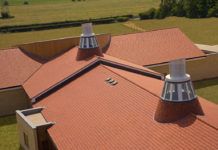 For many years, it has been a requirement that to comply with BS 5534, the number and type of roof tile and slate fixings be calculated for each roofing project. However, this is clearly not done for many projects. More to the point, it is totally impractical for a calculation to be done for every project; roof tile manufacturers would need huge technical support resources to cope with fixing enquiries on that scale. As it is, manufacturers are very busy with the high numbers of enquiries they currently receive.
For many years, it has been a requirement that to comply with BS 5534, the number and type of roof tile and slate fixings be calculated for each roofing project. However, this is clearly not done for many projects. More to the point, it is totally impractical for a calculation to be done for every project; roof tile manufacturers would need huge technical support resources to cope with fixing enquiries on that scale. As it is, manufacturers are very busy with the high numbers of enquiries they currently receive.
Fixing calculations set to increase
With the publication of the latest version of BS 5534, industry awareness of the need to comply with this Standard has risen considerably. It is inevitable, therefore, that the number of projects requiring fixing calculations will continue to increase also.
As it is the roof tile manufacturers who generally provide advice on roof tile fixing, their options are to either increase the number of people who handle such enquiries, or provide on-line tools for their customers to access and obtain instant results.
The method of calculating the necessary fixings for a project is relatively complex, with a considerable amount of information required to calculate the theoretical windload for any given building and location. The theoretical wind load must be determined for the particular building and its location, which is then compared to the wind uplift resistance of a tile or slate and its fixings. Therefore, to achieve this quickly and easily for many projects, the only practical way is through the use of software. For example, Wienerberger’s calculation system uses the site postcode to determine various topographical information, such as distance from sea, height above sea level and proximity to slopes etc. This means the enquirer only need provide some simple and straightforward information; ie postcode, tile type, roof pitch, and building dimensions, in order for a fixing calculation to be calculated.
On-line solutions can make the process much faster for the user; rather than sending an enquiry by email and then waiting for a response, an on-line system will give an instant answer. To make the process quick and easy for the user, an online system may default some elements of the calculations to ?worst case’. This ensures a ?safe’ specification, but of course, could add cost if the fixing specification is too onerous. This may be fine for design or tendering purposes, but then a more detailed specification may be sought prior to commencement of the project.
That is just one example of how online technical tools can assist in the pitched roofing industry. There are other systems though, such as online roof tile quantities calculators. These offer varying levels of complexity. Wienerberger has recently launched such a system that uses pre-determined common roof shapes. Available on the company website at www.wienerberger.co.uk, or directly at www.roofspec.co.uk, QuantSpec is ideal for anyone wishing to obtain an instant quantity estimate for relatively straightforward projects, such as home extensions or even detached homes etc. It is ideally suited for use at building and roofing merchant trade counters. The user just needs to input some basic information about the project, together with the tile type, roof pitch and building footprint dimensions shown on the chosen roof shape. The software then calculates the roof areas and all the required materials, including underlay, battens, tiles, fittings, accessories and dry fix sy




